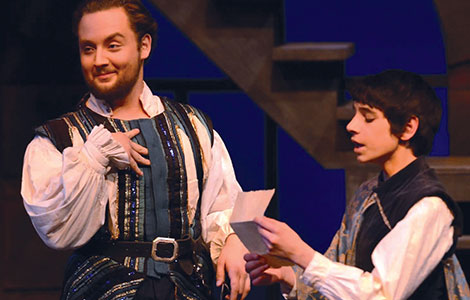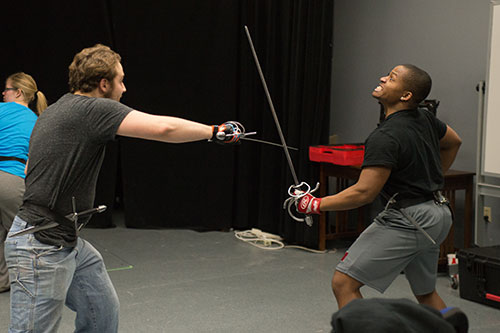‘Romeo and Juliet’ performance was stunning
March 30, 2015
The words are immortal. “Wherefore Art thou Romeo?” They are spoken as young Juliet Capulet laments from her window of the forbidden love. This March, the play that has stood for centuries as the epitome of romance, came to life on the Truax Mitby stage.
Romeo and Juliet is one of my personal favorite stories. I have read and wept through the transcript itself, and have enjoyed the popular film interpretations as well. This live enactment of the classic tale was, by far, the best form in which I have experienced the story. I attended the final performance of the sixth show run on March 15.
While waiting for the show to start, I surveyed the set. The famous balcony stood on one side of a constructed courtyard, with stairs leading up from the ground, to an open hallway above the scene. Soon the lights dimmed to a purple-blue hue and the actors began.
The cast overall carried the dialog beautifully. Iambic pentameter is not something that comes naturally to everyone, but the flow resulting from the impassioned performances consumed my attention for the course of the show.
Individual performances of Shakespeare’s classic characters were also on point, rich, and entertaining. Romeo and Juliet, played by real-life teenagers Rizvan Moe and Kiersten Ott, were as unbridled as two teens in love can be, stealing kisses from one another behind masks. Mercutio, played by Matt Reines, Romeo’s hilarious, tactless, and scheming pal, brought humor to lines that have little meaning in modern context, but were illustrated with rude gestures and gyrations.
The actors of Benvolio and Romeo shared especially good chemistry. Benvolio, played by Carter Campos, convinces Romeo to forget his troubles over Rosaline and attend the dance where he meets Juliet; you could feel a real friendship between the characters as they pranced across the moonlit courtyard. The interactions between Juliet and her nurse, played by Caralynn Shields, were similarly delightful with outrageous gestures and cackling denoting raunchy material.
Serious scenes shook with palpable distaste as Prince Escalus, played by Josh Zytkeiwicz, stormed the stage and rebuked the families for their discord. Lord Capulet, embodied by Jacob Fisher, finds his daughter dead on her lover’s lap, and grieves with a father’s conviction that brought tears to my eyes.
Seamlessly choreographed sword fighting brought even more intensity and drama to the performance. The actors made good use of the ample stage space. I witnessed a duel to the death; Reginald Kellum played the tempestuous Tybalt, who starts the fight that begins the climax of the story. To watch the players fall to their deaths after minutes of jousting amplified their demise.
Tybalt and Mercutio both played dead excellently, their jackets remaining still and breathless, whist action carried on around them.
Within every scene, the lights and music carried the action and dialog, smoothly initiating transitions and changes without a hiccup to be noticed. Overall, the production was stunning and a great indicator of the quality work potential in the Madison College performing arts. But this story is greater than the two hours it takes to perform; its metaphors have kept it relevant for the past several hundred years.
The story of Romeo and Juliet has many reflections in the strife of current society. Children and innocents are often the casualties of war and violence. But I would like to propose that this tale is not in fact the tragedy for which it is known so well.
It is, at its heart, a love tale with a happy ending. We see the love between Romeo and Juliet ignite with their masked meeting and first kisses. It continues to grow, through the balcony scene to their marriage bed to Romeo’s heartbreaking farewell. The inferno rages hottest and then expires as Juliet plunges the happy dagger to her breast. The lovers are dead, but love is not.
True love transcends individuals and the love between the kids is a greater reflection of the love already within all of us, waiting to let us be better to one another. The Montagues and Capulets begin onstage with a strife and at the end, they are not fighting. They weep for the loss of their children and friends, but the sacrifice of the star-crossed pair brings the community together by showing them exactly what they were fighting against: nothing.
The love of the two is the opposite of the basal conflict between the families. Love is always transformational, whether it be lived for four days between teenagers or expressed in the general shift towards acceptance of variety and vibrancy in individuals throughout society.
Romeo and Juliet will continue to resound in hearts as long as there exists both conflict and love, and there’s plenty of that to go around.

